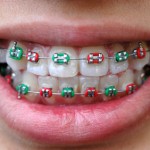
Prominent anterior teeth are considered to be a risk factor for trauma. The aim of this study was to examine the prevalence and incidence of incisor trauma in subjects who participated in a randomized clinical trial designed to investigate early growth modifications in the treatment of Class II malocclusion.
In this trial patients were randomised to three groups during the initial phase of treatment they received either
- headgear or biteplane,
- bionator,
- observation (no treatment).
Following the initial phase all 3 groups underwent phase a final phase with fixed appliances.
At data collection points incisor injury was recorded using the Ellis index by a blinded examiner using dental casts, intraoral photos, and panoramic and periapical x-rays.
They found that
- 25% of the subjects had incisor trauma at the baseline examination with no significant differences related to sex and prevalence of injury
- 28% experienced new or worsening maxillary incisor injury during the study.
- No differences in incidence of trauma were found between the 3 treatment groups throughout the study (P = 0.19);
- Boys were more likely to experience maxillary incisor injury (odds ratio , 2.37; 95% CI, 1.33, 4.21), and those with an injury at baseline were more likely to experience an additional injury (odds ratio , 1.81; 95% CI, 1.03, 3.17).
They concluded
Early orthodontic treatment did not affect the incidence of incisor injury. The majority of the injuries before and during treatment were minor; therefore, the cost-benefit ratio of orthodontic treatment primarily to prevent incisor trauma is unfavourable.
1: Chen DR, McGorray SP, Dolce C, Wheeler TT. Effect of early Class II treatment on the incidence of incisor trauma. Am J Orthod Dentofacial Orthop. 2011 Oct;140(4):e155-60. PubMed PMID: 21967953.
